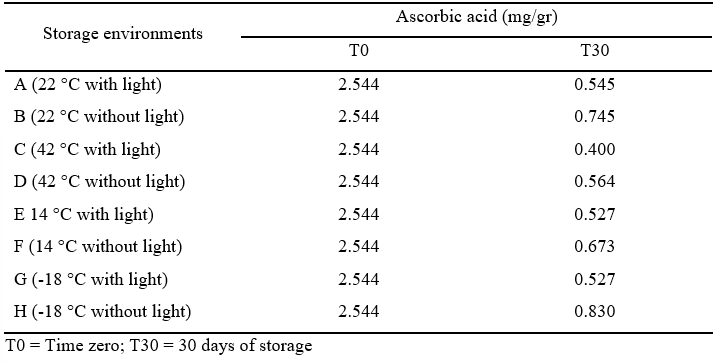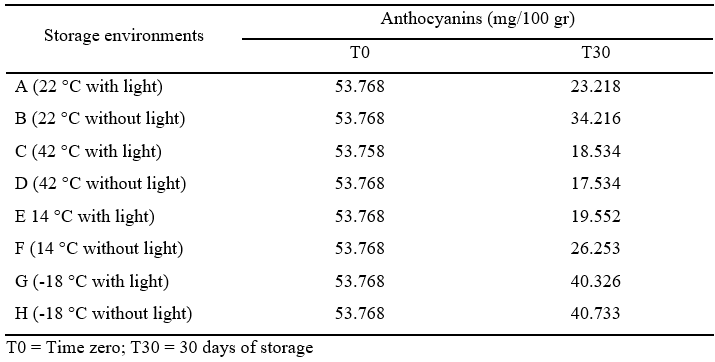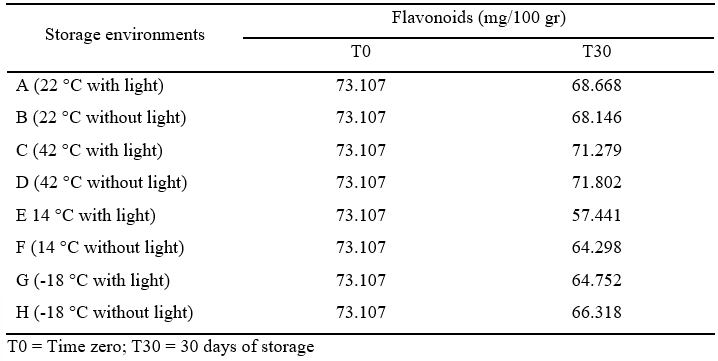EFEITO DA TEMPERATURA E LUZ NA DEGRADAÇÃO DE SUBSTÂNCIAS BIOATIVAS DO CAMU-CAMU
REGISTRO DOI: 10.5281/zenodo.11068464
Jerusa Souza Andrade
Diva Souza Andrade
Jânio Silva Silveira
RESUMO
Os frutos de camu-camu foram colhidos maduros e lavados. A casca foi triturada no liquidificador até a obtenção de uma polpa homogênea. Para obtenção do extrato foram utilizados 500 g de casca triturada, 1,5 litro de álcool acidificado e filtração a vácuo. Durante a filtração foram realizadas sucessivas lavagens (com álcool acidificado), obtendo-se um total de seis litros do extrato filtrado. O extrato foi acondicionado em frascos plásticos transparentes. Metade dos recipientes foram totalmente embrulhada em papel preto e o restante permaneceu transparente sem a proteção. Os recipientes foram mantidos por 30 dias nas temperaturas de -18 °C, 14 °C, 22 °C e 42 °C. No mesmo dia da obtenção do extrato (T0) e aos 30 dias da estocagem (T30) foram realizadas as análises do pH, e dos conteúdos de ácido ascórbico, antocianinas e flavonoides. Houve variações no conteúdo de substâncias bioativas em função do tempo de estocagem, da luminosidade e do aumento da temperatura. Todas as substâncias analisadas mostraram perdas durante o período de estocagem. Essas perdas foram maiores quando em presença da luz em quando mantidas nas temperaturas mais altas.
Palavras-chave: casca; extrato alcoólico; ácido ascórbico; flavonoides; antocianinas.
ABSTRACT
The fruits of camu-camu were harvested ripe and washed. The peel (skin) was crushed in a blender until obtaining a homogeneous pulp. To obtain the extract, 500 g of pulp and 1.5 liters of acidified alcohol and vacuum filtration were used. During filtration, successive washes were performed (with acidified alcohol), obtaining a total of six liters of filtrate. The extract was packaged in transparent plastic bottles. Half of the containers were fully wrapped in black paper and the rest remained transparent without the protection of black paper. The containers were kept for 30 days at temperatures of -18 °C, 14 °C, 22 °C and 42 °C. On the same day the extract was obtained (T0) and 30 days after storage (T30), the pH and ascorbic acid, anthocyanin and flavonoid contents were analyzed. There were variations in the content of bioactive substances as a function of storage time, light and temperature increase. All analyzed substances showed losses during the storage period. These losses were greater when in the presence of light and when kept at higher temperatures.
Keywords: peel;alcoholic extract; ascorbic acid; flavonoids; anthocyanins.
INTRODUCTION
Camu-camu (Myrciaria dubia McVaugh) is a plant of the Myrtaceae family and has its natural occurrence dispersed in almost the entire Amazon. Camu-camu is found in the wild on the banks of rivers and lakes. In its natural habitat, the plant can be submerged for 4 to 5 months. When cultivated, camu-camu produces in non-flooded lands (uplands) of the Amazon (Alvarado Vertiz, 1969; McVaugh, 1969: Andrade, 1991; Silveira, 1998).
Since the 1980s, camu-camu has been highly sought after for consumption due to the dissemination of its nutritional value. The first studies on the fruit began in Peru. Later in Brazil, the Instituto Nacional de Pesquisas da Amazônia began studies on the cultivation of the plant in non-flooded lands, on the technological use, post-harvest physiology and nutritional value (Andrade et al., 2021).
Flavonoids are secondary metabolites of plants and protect the body against the action of oxidizing agents. Flavonoids have therapeutic effects that result in a decrease in the incidence of diseases related to oxidative stress (Martínez-Flórez et al, 2002; Asolini et al., 2006).
Anthocyanins are pigments of the flavonoid group and are responsible for the orange-red, deep red, purple and blue colors of fruits, flowers and some leaves ((Jackman et al., 1987a). In camu-camu, anthocyanins are responsible for the red-purple color of ripe fruit.
Among the fruits of the Amazon, camu-camu stands out for its high content of ascorbic acid and the presence of flavonoids and anthocyanins that provide an attractive red color. The preservation of these substances is essential, since their degradation is directly related to their nutritional value and their attractive red color. This work aimed to evaluate the influence of temperature and light on the degradation of bioactive substances in camu-camu.
MATERIAL AND METHODS
The fruits of camu-camu were harvested from plants cultivated in the floodplain region at the fruit growing station of the Instituto Nacional de Pesquisas da Amazônia (INPA) located in the municipality of Iranduba, Amazonas, Brazil. The fruits were packed in boxes, and transported to the Department of Food Technology at INPA in Manaus, where the experiment was conducted.
The fruits were selected and washed in running water. Manually (with the aid of a spatula) the peel (skin) was separated from the pulp and seed. The peel was crushed in a blender until obtaining a homogeneous pulp.
To obtain the extract, 500 g of homogeneous pulp and 1.5 liters of acidified alcohol were used according to Lees & Francis (1972). The mixture was transferred to a glass container (2-liter capacity), and stored in a refrigerator (4°C) overnight. The mixture was filtered through Whatman #1 filter paper using a vacuum pump. During filtration, the residue and filter paper were washed several times, resulting in a total of six liters of filtrate (extract).
The extract was divided into eight transparent plastic bottles (350 mL capacity). About 300 mL of the extract were added to each bottle. Half of the containers were fully wrapped with carbon paper (black) to protect against light. The remainder remained transparent without the protection of black paper, and consequently, without protection against light.
The containers (with and without light protection) were kept for 30 days at -18 °C (freezer), 14 °C (refrigerator), 22 °C (laboratory) and 42 °C (stove). The environments were coded as A (22 °C with light), B (22 °C without light), C (42 °C with light), D (42 °C without light), E (14 °C with light), F 14 °C without light), G (-18 °C with light) and H (-18 °C without light). On the same day of obtaining the extract (T0) and 30 days after storage (T30) the analyzes were carried out.
To determine the pH, 50 mL of the extract were used and the reading was performed in a Micronal® pH meter, mod. B 221, previously calibrated with buffer solutions 7 and 4. The ascorbic acid content was obtained by titration with 2,6-dichlorophenolindophenol solution (Ranganna, 1986). For the determination of anthocyanins and flavonoids, aliquots of the extract were taken and diluted with the same extraction solvent. Readings were taken at 535 nm and 374 nm for anthocyanins and flavonoids, respectively (Lees & Francis, 1972).
RESULTS AND DISCUSSION
There were variations in the content of bioactive substances as a function of storage time, light, and temperature increase. There was no influence of temperature and light during the 30 days of storage on pH values. All showed pH 1.0 for all extracts.
Ascorbic acid showed degradation during the storage period (Table 1). Greater degradation was observed in environments with light and higher temperatures. According to Mapson (1970) and Aragão et al. (1996), ascorbic acid is degraded by the action of oxidative enzymes and light.
During storage, loss of anthocyanin levels was observed; these losses were greater when in the presence of light and when kept at higher temperatures (Table 2). This behavior is similar to those reported by Jackman et al. (1987a, b).
Similar to the other constituents analyzed, the flavonoid content decreased during storage and more markedly at higher temperatures and in the presence of light (Table 3). The flavonoid contents are similar to those found by Silveira (1998).
Table 1. Effect of light, temperature and storage time on the ascorbic acid content in the alcoholic extract of camu-camu peel

Table 2. Effect of light, temperature and storage time on anthocyanin content in the alcoholic extract of camu-camu peel

Table 3. Effect of light, temperature and storage time on the flavonoid content in the alcoholic extract of camu-camu peel

CONCLUSION
There were variations in the content of bioactive substances as a function of storage time, light, and temperature increase. All analyzed substances showed losses during the storage period. These losses were greater when in the presence of light and when kept at higher temperatures.
ACKNOWLEDGEMENTS
The authors thank Janete Marly Pontes da Silva (in memoriam) who was a PIBIC-INPA/Manaus scholarship holder, and who, under the guidance of the other authors, conducted the experiments and analyzes in the laboratory
REFERENCES
Andrade, J.S. Curvas de maturação e características nutricionais do camu-camu Myrciaria dubia (H.B.K.) Mc Vaugh cultivado em terra firme na Amazônia Central Brasileira. Tese de doutorado, UNICAMP, 177p. 1991.
Andrade, J.S.; Rodrigues, A.A.M.; de Souza, R.S. Camu-camu post-harvest and processing technology to maintain its nutritional qualities and improve its sensory attributes. In Ciência e Tecnologia de Alimentos: pesquisa e práticas contemporâneas – Volume 2, cap. 18, p. 253-264, 2021.
Aragão, C.G.; Ikegaki, M.; Sato, H.; Oliveira, I.M.; Park, Y.K. Determination of ascorbic acid concentration in acerola and camu-camu fruit juices by ascorbate oxidase method. Ciência e Tecnologia de Alimentos, v. 16, n. 2, p. 175-176, 1996.
Asolini et al. Atividade antioxidante e antibacteriana dos compostos fenólicos dos extratos de plantas usadas como chás. Brazilian Journal of Food Technology, v. 9, n. 3, p. 209-215, 2006.
Jackman, R.L.; Yada, R.Y.; Tung, M.A. Anthocyanins as food colorant – a review. Journal of Food Biochemistry, v. 11, n. 3, p. 201-247, 1987 a.
Jackman, R.L.; Yada, R.Y.; Tung, M.A. A review: separation and chemical properties of anthocyanins used for their qualitative analysis. Journal of Food Biochemistry, v. 11, n. 4, p. 279-308, 1987 b.
Lees D.H. & Francis, F.J. Standartization of pigment analyses in cranberries. Hort. Science, v. 7, n. 4, p. 83-84, 1972.
Mapson, L.W. Vitamins in fruits. In: Hulme, A.C. The biochemistry of fruits and their products. London, Academic Press, v. 1, p. 369-384, 1970.
Martínez-Flores et al. Los flavonoides: propiedades y acciones antioxidantes. Nutrición Hospitalaria. v. 17, n. 6, p. 271-278, 2002.
Mc Vaugh, R. Botany of the Guyana highland. Part VIII. Memoirs of the New York Botanical Garden, New York, v. 18, n. 2, p. 55-286, 1969.
Silveira, J.S. Efeito do estádio de maturação na conservação pós-colheita de camu-camu (Myrciaria dubia H. B. K. Mc Vaugh). Dissertação de mestrado, Universidade Federal do Amazonas, 135 p. 1998.
1Instituto Nacional de Pesquisas da Amazônia
*E-mail: jerusa.andrade@uniniltonlins.edu.br
2Instituto de Desenvolvimento Rural do Paraná
